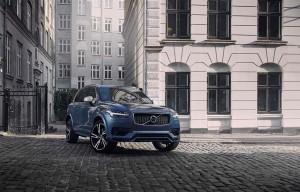
Volvo Cars North America CEO Anders Gustafsson with images of some of the first workers at the automaker’s new Charleston plant.
U.S. new vehicle sales are on course to post their second consecutive decline as 2018 draws to a close, but you’d have a hard time telling that if you were just looking at Volvo’s numbers.
The Swedish automaker has posted a 27% jump in demand through the end of October and, with more products ready to land in U.S. showrooms, Volvo Cars USA CEO Anders Gustafsson said Thursday he is optimistic the company can keep its momentum growing.
Several factors could give meaning to his forecast, including not just the launch of the new Volvo S60, but the start of production at the Chinese-owned automaker’s first U.S. assembly plant in Charleston, South Carolina. Then there’s Care by Volvo, the subscription program the carmaker launched late last year.
(Click Here for a review of the new, 2019 Volvo V60.)
While subscription programs are rapidly proliferating across the industry, especially in the premium sector, Volvo was one of the first to introduce the concept. Its version allows a shopper to choose a vehicle, option it out and then line up a fixed monthly price – including everything from the vehicle itself to taxes, fees and insurance. For the moment, the Care by Volvo program is limited to the new XC40 SUV but other models will be added to the subscription service, said Gustafsson, during a lunch meeting with reporters at the Automotive Press Association in Detroit.

Hieth Rogers. one of the first Care by Volvo customers , demonstrated how to do it at last year’s LA Auto Show.
So far, about 14% of the new XC40s Volvo has sold were acquired through the Care program, Gustafsson noting that “the typical customer is about 10 years younger” than those for Volvo’s U.S. subsidiary, overall, and likely someone who wouldn’t have chosen a Volvo if the alternative wasn’t available.
The Care program, he noted, will not only grow but also have to evolve. Care customers currently sign on for two years, though they can trade in for a new version of the XC40 after 12 months. Unlike a lease, there is no option for a Care customer to then buy out the vehicle, though Gustafsson told TheDetroitBureau.com in a separate conversation that Volvo is exploring ways to reward loyal customers who might then want to stay in the subscription program.
Separately, Volvo is planning to set up a version of Care that will focus on used vehicles, much like its more traditional certified pre-owned, or CPO, program. That would likely launch as the first of the XC40s covered by the current Care program are returned, something likely to happen over the next 12 months.
(Learn more about Volvo’s warranty plans.)
Going forward, Volvo will all but certainly extend Care to cover other models, possibly including the XC90 that it will start building at the new Charleston plant in 2022. In particular, Volvo is likely to emphasize subscriptions for the battery-electric vehicles it is planning to market in large numbers over the coming decade. All told, Volvo expects to be selling 1 million hybrids and all-electric models annually by 2025.
Many potential customers have been wary about the low residual values – or trade-in prices – on today’s electric vehicles and, the VC USACEO said that will likely continue to be a problem, but one that a subscription program could make irrelevant to customers.
(Why is Cadillac abandoning its subscription program? Click Here to find out.)
In a wide-ranging discussion, Gustafsson acknowledged Volvo may have to make some shifts in its strategy for that new South Carolina plant because it was initially conceived as a major export base, with about half of its output intended for Europe, China and other markets.
The tit-for-tat trade war launched by the Trump Administration has forced Volvo to rethink its plans, what with China now enacting a 40% duty on American-made vehicles. Gustafsson said that should have a “small” impact, but things could grow a lot more problematic if the president follows through with what is known as a “232” tariff on imports, a reference to the federal rule that allows imports to be made subject to tariffs if they create a threat to national security.
That would be a “bigger, bigger problem,” Gustafsson said, as trade partners would likely respond by increasing tariffs on American-made vehicles. But he added his belief that such a move won’t materialize because the issue “will be resolved by common sense.”
Over the last three years Volvo has completely replaced its old product line-up. But there has been a downside. The company scored at the bottom of the latest Automotive Reliability Survey released last month by Consumer Reports magazine.
(What’s included in a Volvo extended warranty?)
The VC USA chief acknowledged the problem, especially with the pioneering XC90 model that marked the start of the product transition. He added that Volvo has been working with customers to address their concerns, while also trying to solve problems with its suppliers. That, he insisted, has been proving out in the form of declining warranty costs.
They “are going in the right direction,” said Gustafsson, and should show up in the form of improved quality and reliability scores going forward.
(Click Here for a look at how the entire industry fared in the Consumer Reports Automotive Reliability Survey.)

